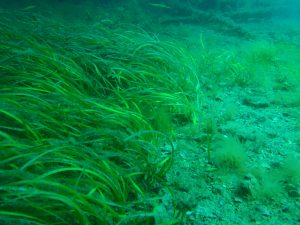… providing carbon capture and essential habitats
.
We need to be looking after our seabeds:
Marine conservation after Brexit – Vision Group for Sidmouth
A new Radio 4 series took us to the sea floor:
39 Ways to Save the Planet, Sublime Seagrass
Simple and sublime seagrass meadows work naturally to absorb carbon. The leaves cause friction in the water and trap carbon from organic matter in the sediment. Yet industrial activity and pollution has damaged and reduced the extent of the meadows around the UK coast. With the marine environment improving, work is being done to restore patchy seabeds and create new ones, both in the UK and around the world. Take a dip with Tom Heap as he explores the wonders and potential of these plants on the sea floor.
BBC Radio 4 – 39 Ways to Save the Planet, Sublime Seagrass
But it’s not just as carbon storage that seagrass fulfills a useful role – but as an essential habitat.

The Inshore Fisheries and Conservation Area for Devon and the Severn has surveyed seagrass in the area – and brought in measures to protect it, resulting in an impressive increase in fish too:
Seagrass is one of the features of the Torbay Marine Conservation Zone and the conservation objective for the seagrass beds is to “recover to favourable condition”.
Habitat Mapping – Devon and Severn IFCA
And in Lyme Bay, the seagrass is proving handy as habitat for a specific species:
Cuttlefish Eggs
Common or European cuttlefish eggs grow attached to seagrass, Zostera marina, blades or rocks. Cuttlefish arrive in shallow bays and estuaries in spring to lay their eggs in seagrass beds. Cuttlefish eggs are often called sea-grapes because they are laid in bunches and look very much like a bunch of black grapes.
Marine Life | Lyme Bay Fisheries & Conservation Reserve
Black Seabream
‘Spondyliosoma cantharus’ is a species that is most commonly found in areas with rocky or sandy bottoms and seagrass beds up to about 300m in depth (mainly between 10m and 100m). Juveniles usually live in shallower water and tend to remain further inshore until about two or three years of age…
Commercial Species | Lyme Bay Fisheries & Conservation Reserve
.
image: File: Seagrass at Rapid Bay Jetty P1262907.JPG – Wikimedia Commons